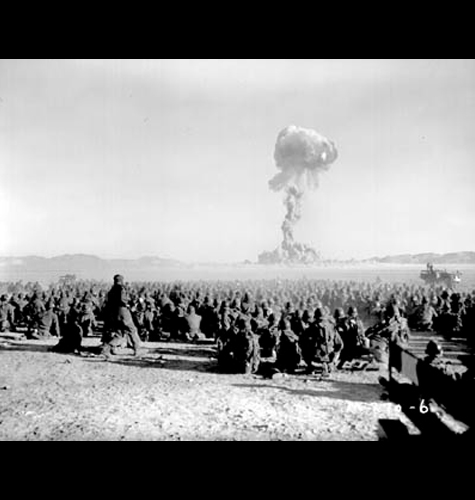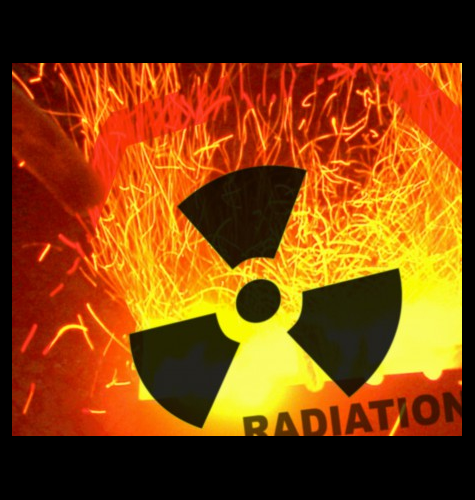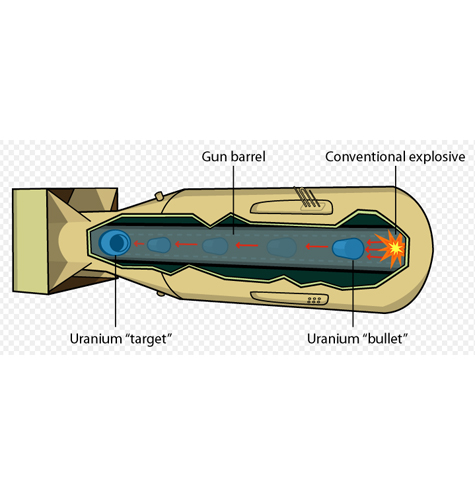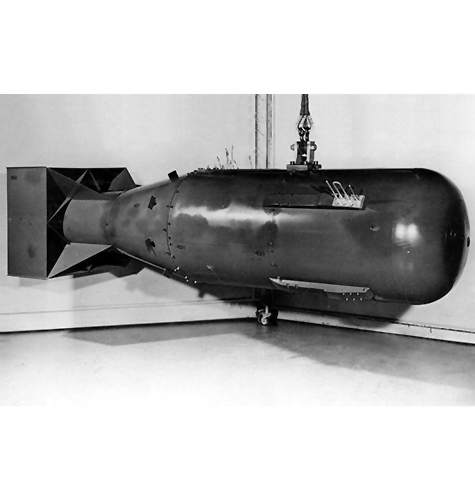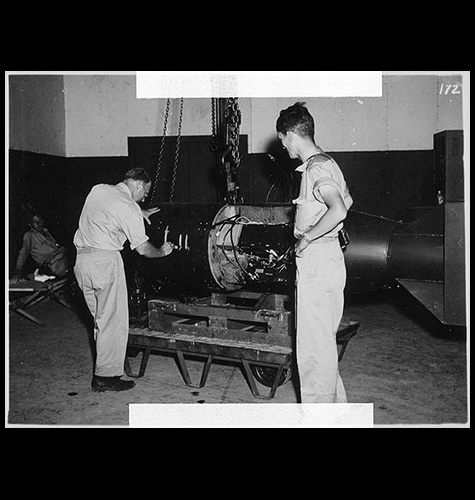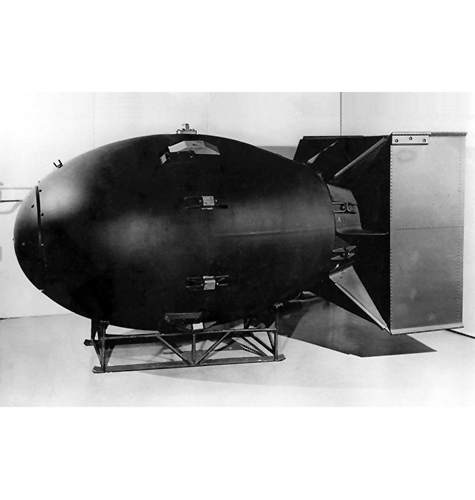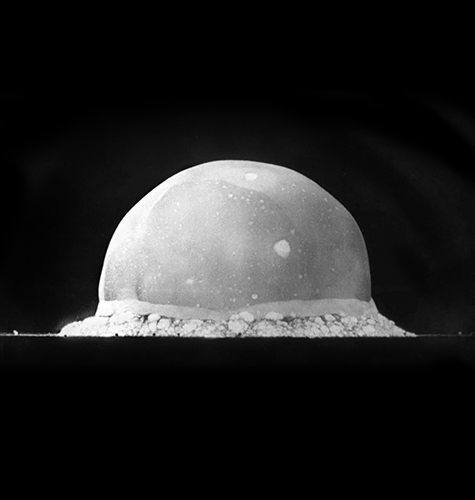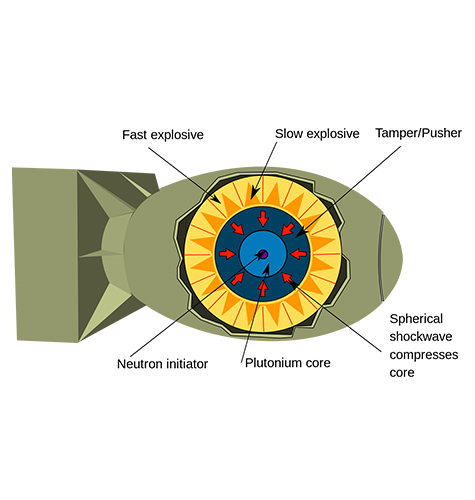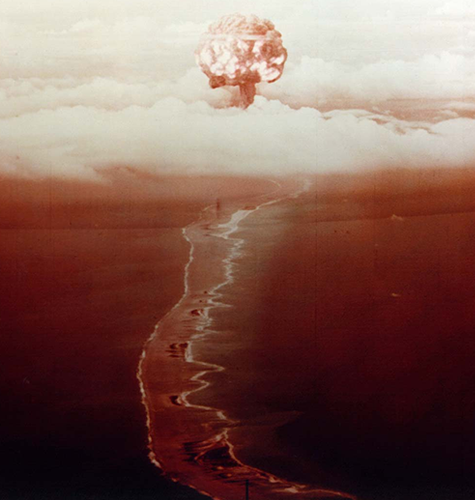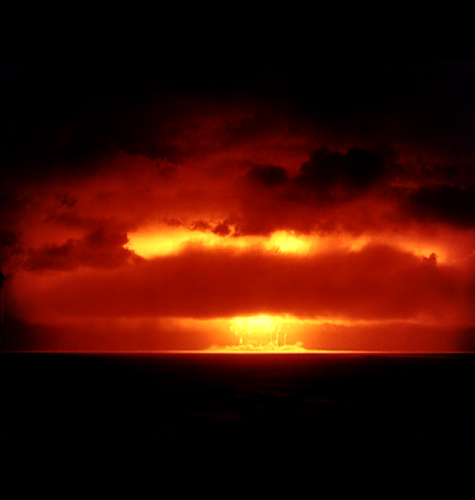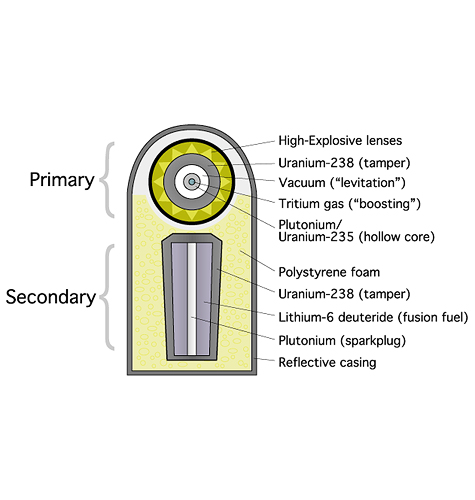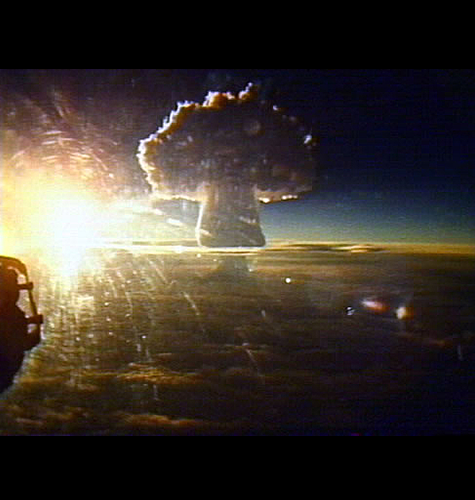Updated: 2023
What are nuclear weapons?
- A nuclear weapon is a weapon that derives its incredible destructive force from the sudden release of the energy created by a self-sustaining nuclear fission and/or fusion reaction.
- Fission-based weapons derive their energy from the splitting of atoms, which includes all first-generation U.S. nuclear weapons, including the bombs dropped on the Japanese cities of Hiroshima and Nagasaki. Modern nuclear weapons are far more destructive and derive some or most of their explosive yield from another process called fusion.
- Fusion is conceptually the inverse of fission, fusing rather than splitting atoms. When two or more light atoms (e.g., hydrogen isotopes deuterium and tritium), fuse, a large amount of energy is released.
How Fusion Works
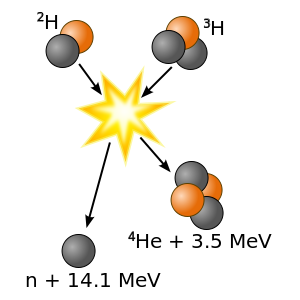 Image Source: WikiMedia Commons
Image Source: WikiMedia Commons
- Fusion can only occur under intense heat and pressure similar to the temperature of the sun’s core. In fact, the sun generates its energy purely through the fusion process. Weapons designers produce the conditions for fusion through the use of a “primary” fission explosion to trigger a fusion-based “secondary.” This is why to-date it has been prohibitively difficult to harness fusion for peaceful applications; facilities such as the U.S. National Ignition Facility conduct fusion experiments in the hopes of eventually being able to do so.
How are nuclear weapons different from conventional weapons?
- The humanitarian, economic, and environmental consequences of nuclear war are unimaginable. While the likelihood of a full-scale nuclear exchange has decreased significantly since the U.S.-Soviet Cold War, the continued existence of around 15,700 nuclear weapons poses ongoing risks of intentional, accidental or unauthorized nuclear weapons use. [1]
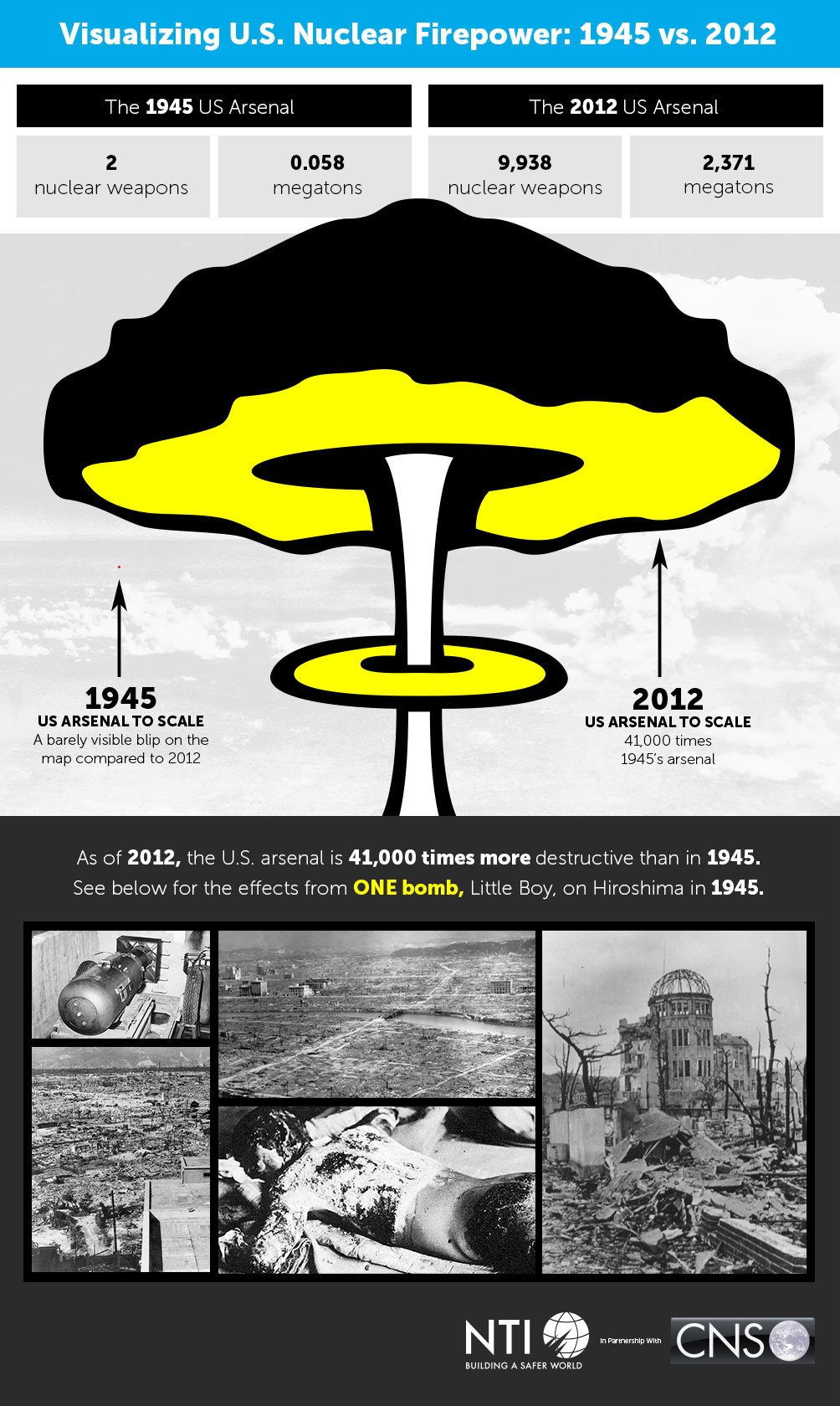
- Nuclear reactions, whether fission or fusion, allow nuclear weapons to harness far greater energy than conventional explosives, which rely upon chemical reactions. Fissioning one kilogram of a fissile material, such as uranium-235 or plutonium-239, can generate about 15 million times more energy than one kilogram of the conventional explosive TNT.
- Nuclear explosions are typically measured using a standard unit known as tons of TNT equivalent. For example, the W87, a modern U.S. nuclear weapon, has an explosive yield of 300 kilotons, which is equivalent to 300,000 tons of TNT.
- The difference is not just about the size of a nuclear explosion, but also the unique effects it generates. The enormous destructive power of a nuclear weapon comes from the blast (which causes shock waves); thermal radiation (which generates enormous heat); nuclear radiation (which has both short and long-term effects), and the Electromagnetic Pulse (which is a short burst of electromagnetic energy that disrupts and damages electronics and other infrastructure).
Slideshow: Effects of a Nuclear Explosion
What are the different kinds of nuclear weapons?
Slideshow: Nuclear Weapon Types
Thermonuclear Weapon
How much fissile material is required to build a nuclear weapon?
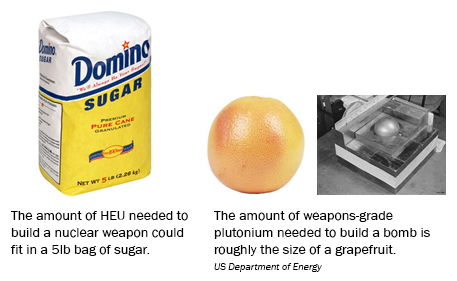
- The amount of fissile material required to build a nuclear weapon, often referred to as a critical mass, varies based on whether plutonium or HEU is used; the quality of the plutonium and/or enrichment level of the HEU; and many other design considerations, such as whether the weapon’s design employs a neutron reflector (which reduces the amount of material needed).
- The first implosion nuclear weapon, “Fat Man,” used 6 kg of plutonium. If 90% HEU had been used in a similarly primitive design, it would have required about 20 kg of HEU. [3] The United States has declassified the fact that 4 kg of plutonium is sufficient to build a modern nuclear weapon, and some experts suggest a modern HEU-based weapon might contain only 12 kg of HEU. [4]
- To help guide the development of nuclear safeguards, the International Atomic Energy Agency (IAEA) developed the concept of a significant quantity (SQ), defined as “the approximate amount of nuclear material for which the possibility of manufacturing a nuclear explosive device cannot be excluded.” The current IAEA safeguards standard sets a significant quantity at 25 kg of uranium-235 in HEU and 8 kg of plutonium. The significant quantity is different than the technical amount of materials needed because it is a standard agreed upon by the international community as the basis for applying IAEA safeguards. It is widely acknowledged to be higher than the minimum amount of nuclear material required to build a weapon in an efficient design.
How difficult is it for a country to develop nuclear weapons?
Developing nuclear weapons is a complex endeavor, requiring substantial financial, technical, and human resources; however, these barriers are not insurmountable, and many countries could develop nuclear weapons if they chose to do so.
Step 1: Acquiring Fissile Material

Acquiring fissile material is the most significant hurdle to a nuclear weapons capability, requiring a country to enrich uranium, produce plutonium, or illicitly procure such materials through theft or purchase.
Step 2: Weapons Fabrication
![]()
- Individuals with expertise in chemistry, physics, metallurgy, electronics, and explosives would be required to design and fabricate a nuclear weapon. Many non-nuclear components and high-end manufacturing techniques are also required.
- However, the basic design concepts are in the public domain, and many of the components and manufacturing techniques could be procured legitimately because of their dual-use nature. Modern proliferators would benefit from advances in high-performance computing (supercomputers), which were unavailable to the first nuclear weapons programs.
Step 3: Testing

- Countries use nuclear testing to validate whether a particular nuclear weapon design works. For an unsophisticated design, such as a gun-type weapon, nuclear testing is not necessary to provide high confidence a bomb will detonate.
- Weapons designers would need to test the non-nuclear components in an implosion-based weapon, but might not need to conduct a full-scale nuclear text. Testing at full nuclear yield would be required for a country seeking very low-weight weapons, or thermonuclear weapons.
- All five nuclear weapon states recognized by the NPT and at least three of the four additional nuclear weapons possessing states have conducted nuclear tests. All but one of these countries (North Korea) currently observe testing moratoria. Because of the Comprehensive Nuclear Test Ban Treaty Organization’s (CTBTO) International Monitoring System, conducting clandestine nuclear tests is extremely difficult.
Step 4: Delivery Systems

- In addition to the nuclear weapon’s design, the sophistication of a country’s delivery systems—such as missiles, combat aircraft and drones—determine how, when and against whom a country can use nuclear weapons. These systems also enable states to deploy their nuclear forces for deterrence and signaling purposes.
- States prefer aerial methods of delivering nuclear weapons (and especially ballistic missiles) because they are fast, cover large distances, carry large payloads and can penetrate an adversary’s defenses.
- Long-range systems place tight constraints on the size and weight of nuclear weapons. Miniaturization to fit a nuclear weapon atop a missile, for example, can pose significant challenges to a proliferating country, and would require nuclear testing.
- Non-state actors such as terrorists may resort to crude delivery methods to carry out attacks. Were such groups to build a crude nuclear device, a human carrier, truck, cargo shipping container, or a civilian aircraft could be sufficient to deliver it to a target.
How many countries have developed nuclear weapons?
Rotate your device horizontally to improve chart display.
Nuclear Stockpiles
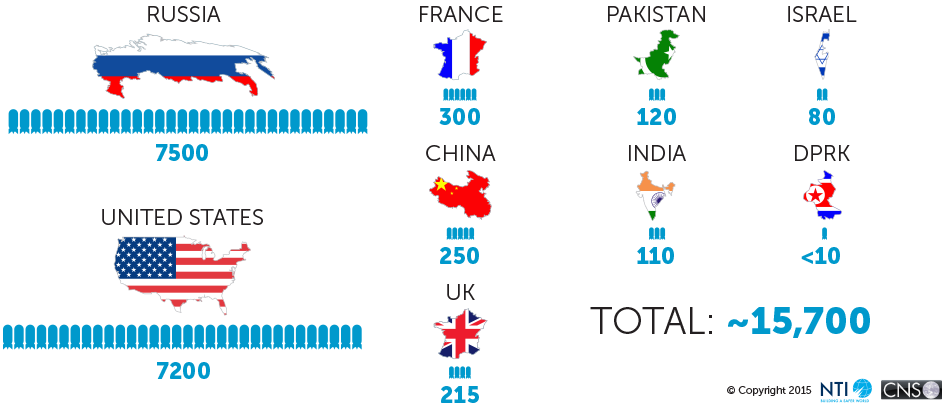
Nuclear Holdings
- Nine countries possess nuclear weapons: China, France, India, Israel, North Korea, Pakistan, Russia, the United Kingdom, and the United States. South Africa also developed nuclear weapons, but voluntarily gave them up in the early 1990s.
- Many other countries are believed to have the technological capacity to develop nuclear weapons. To learn more about why the vast majority of countries have not acquired nuclear weapons, see the Nonproliferation Regime Tutorial.
Sources:
[1] “Status of World Nuclear Forces,” Federation of American Scientists, 2015, www.fas.org.
[2] “Nuclear Detonation: General Information,” U.S. Department of Health and Human Services, http://www.remm.nlm.gov/nuclearexplosion.htm#categories; “Electromagnetic pulse,” Glossary of the Comprehensive Test Ban Treaty Organization, http://www.ctbto.org/glossary/?letter=e&cHash=388a6c115d.
[3] Global Fissile Material Report 2013: Increasing Transparency of Nuclear Warhead and Fissile Material Stocks as Steps toward Disarmament, International Panel of Fissile Materials, October 2013, p. 92.
[4] Global Fissile Material Report 2013: Increasing Transparency of Nuclear Warhead and Fissile Material Stocks as Steps toward Disarmament, International Panel of Fissile Materials, October 2013, p. 92.
[1] “Status of World Nuclear Forces,” Federation of American Scientists, 2015, www.fas.org.
[2] “Nuclear Detonation: General Information,” U.S. Department of Health and Human Services, http://www.remm.nlm.gov/nuclearexplosion.htm#categories; “Electromagnetic pulse,” Glossary of the Comprehensive Test Ban Treaty Organization, http://www.ctbto.org/glossary/?letter=e&cHash=388a6c115d.
[3] Global Fissile Material Report 2013: Increasing Transparency of Nuclear Warhead and Fissile Material Stocks as Steps toward Disarmament, International Panel of Fissile Materials, October 2013, p. 92.
[4] Global Fissile Material Report 2013: Increasing Transparency of Nuclear Warhead and Fissile Material Stocks as Steps toward Disarmament, International Panel of Fissile Materials, October 2013, p. 92.

